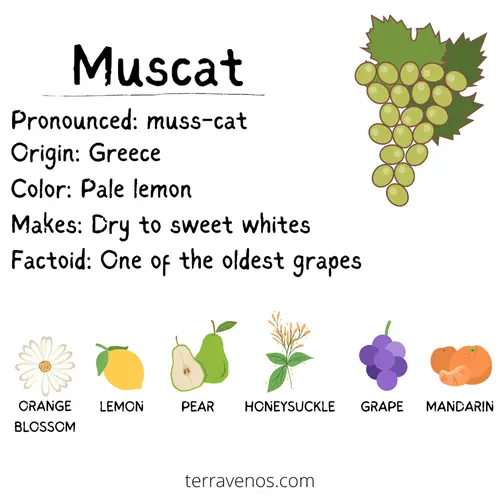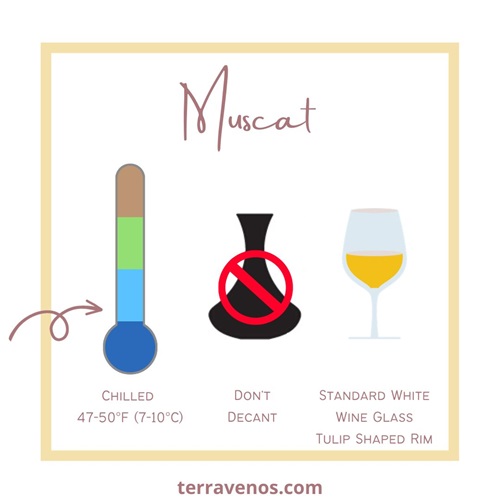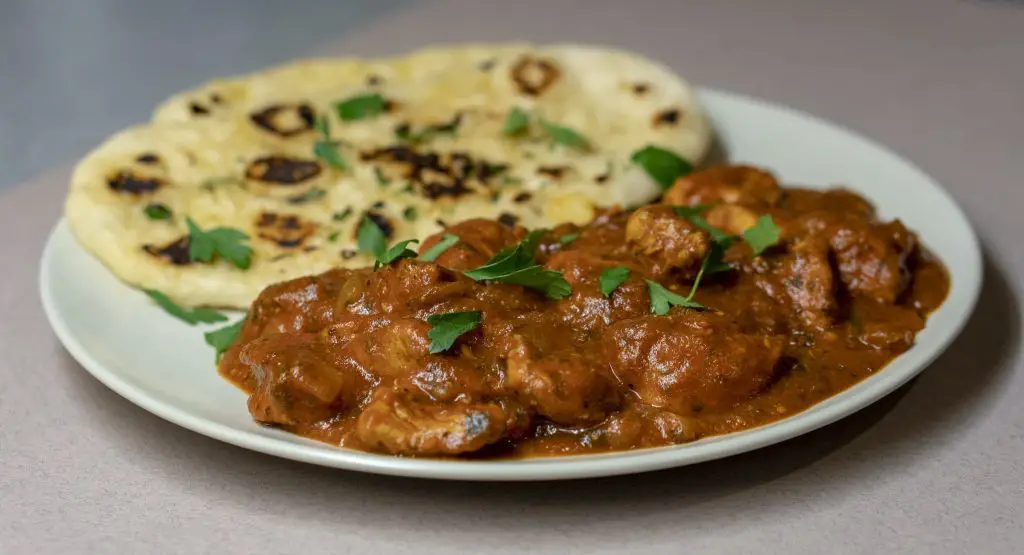
Pronunciation: MUHS-kat
Muscat is an ancient family of over 200 aromatic grape cultivars. Muscat wine makes dry, sweet, sparkling, and even fortified styles. Muscat delivers aromas of orange blossom, citrus, and grape.
Here’s what you need to know about Muscat wine.
- What Kind of Wine Is Muscat?
- Where Does Muscat Wine Come From?
- Key Muscat Varieties
- What Does Muscat Smell Like?
- What Does Muscat Taste Like?
- Is Muscat a Heavy Wine?
- How to Serve Muscat Wine
- Muscat Synonyms
- Is Muscat the Same as Muscadine?
- Is Moscato the Same as Muscat?
- Muscat Food Pairing Suggestions
- Muscat vs. Other Varietals
- Notable Muscat Producers and Bottles to Try
- Emerging Trends and Innovations
- Final Thoughts – Muscat as a Must-Try White Wine Varietal
- Thirsty for More?
What Kind of Wine Is Muscat?

Muscat is a versatile white wine with a pronounced floral and fruity aroma, often featuring notes of orange blossom, grapefruit, and musk. It can be crafted into a variety of styles, from sweet dessert wines to dry still wines, fortified wines, and even sparkling wines.
One of the beautiful things about Muscat wines is that they are very aromatic and perfumed so you can typically pull out their aromas quite easily.
Fun Wine Factoid: Wine aromas can come from the grape or from fermentation and winemaking processes. Muscat is rich in monoterpenes which are the aroma compounds in the grape itself like linalool, geraniol, and nerol which produce floral, blossom, rose, citrus, and grapey aromas. You can find these same compounds listed on the back of hand lotion bottles. Who knew?
Where Does Muscat Wine Come From?
Muscat has ancient roots, and its cultivation spans across various wine-producing regions. Muscat’s exact origins are unknown, but the Greeks and Egyptians most likely enjoyed Muscat wines. Muscat needs a long, hot growing season making this little grape a popular choice throughout the Mediterranean. It also thrives in France, Spain, Australia, South Africa, and California.
(Unhelpful) Fun Wine Fact: There is no one Muscat grape. It’s a family of grapes. Wine labeling around the world makes figuring out what exact Muscat grape went into the wine a bit challenging.
Key Muscat Varieties
Muscat Blanc à Petits Grains / Moscato Bianco
Exploring Muscat Blanc à Petits Grains / Moscato Bianco
🍇 Overview:
- Considered the oldest and most esteemed member of the Muscat family.
- Often referred to as the most “noble” Muscat cultivar, renowned for producing exquisite and long-lasting aromatic wines across diverse styles.
📌 Characteristics:
- French name implies small berries, but with thin skins.
- Vulnerable to various pests, diseases, and rot.
🌍 Geographical Presence:
- Spans the length of Italy, from Asti and Moscato d’Asti in Piedmont to Chambave’s Muscat in the Aosta Valley.
- Also found in Tuscany, Puglia, Sardinia, and Sicily, where it goes by different names like Moscato di Trani and Moscato di Noto.
🏰 Historical Roots:
- Thought to be one of the oldest grape varieties in France, introduced by the Romans, Greeks, or Phoenicians. Who knows?
- Originates around Frontignan on the Mediterranean coast, frequently encountered in Languedoc-Roussillon and the southern Rhône.
🌐 Global Aliases:
- Known as Gelbermuskateller in German-speaking countries, Tamjanika in parts of Eastern Europe, and Moschato Samou in Greece.
🌍 International Travels:
- Transplanted to South Africa as Muscat de Frontignan, contributing to the famous Vin de Constance wines of Constantia.
- Klein Constantia’s modern interpretation is recognized as a world-class Muscat dessert wine.
🍷 Varietal Forms:
- In addition to the standard form, it also exists in a dark-skinned version, Muscat à Petits Grains Rouge, influencing Australia’s renowned Rutherglen Muscat (known as Rutherglen Brown Muscat).
Exploring Muscat of Alexandria (Zibibbo)
🍇 Profile:
- Also known as Zibibbo in Sicily, Muscat of Alexandria is a varietal nearly as ancient as Muscat Blanc à Petits Grains.
- Flourishes in a typical Mediterranean climate, extending its cultivation around the Mediterranean Sea and beyond.
🏞️ Cultivation and Characteristics:
- Known for its resilience and high yield.
- Frequently utilized as a substitute for Muscat Blanc à Petits Grains due to its mixed reputation as a wine grape, often obscured by generic labels like “Muscat” or “Moscadel.” (unhelpful)
🍇 Global Presence:
- Plays a significant role in various regions:
- Southern Spain: Contributes to the raisins and wines of Malaga.
- Central Portugal: Found in the wines of Setubal.
- Southwest France: Featured in Muscat de Rivesaltes in the Roussillon.
- Tunisia: Utilized for both table grapes and wine.
- Chile’s Itata Valley: Successfully transplanted to distant Chilean soils.
🍷 Enduring Legacy:
- Muscat of Alexandria is responsible for the distinctive raisins and wines of Malaga in southern Spain, reflecting its enduring influence across different terroirs.
Helpful Tip: Check out this full Zibibbo wine guide.
Exploring Moscato Giallo / Goldmuskateller
📌 Italian Heritage:
- Moscato Giallo, an Italian native, emerges as a descendant of Muscat Blanc à Petits Grains. However, details about its other parent and the precise date of its introduction to viticulture in Italy remain shrouded in mystery.
🌍 Geographical Concentration:
- Predominantly found in northern Italy, with strongholds in Trentino and Friuli, where it thrives.
🏞️ International Identities:
- Beyond Italy, in Austria, Germany, and parts of Südtirol, it adopts the names Goldmuskateller or Goldenmuskateller, reflecting its golden or gold-like attributes.
🍇 Genetic Lineage:
- As an offspring of Muscat Blanc à Petits Grains, Moscato Giallo inherits qualities that contribute to its unique flavor profile and aromatic potential.
🏞️ Preferred Terroirs:
- Flourishes in the northern Italian climates of Trentino and Friuli, showcasing its adaptability to specific geographical conditions.
🍷 Tasting Diversity:
- The varietal offers a diverse range of tasting experiences, influenced by its Italian origins and the nuances brought forth in Austria, Germany, and Südtirol.
Unraveling the Tale of Muscat Ottonel
🍷 French Roots:
- Muscat Ottonel traces its origin to France, born as a cross between Chasselas and Muscat Ingram. Notably, Muscat Ingram itself has Muscat Blanc à Petits Grains as one of its parents.
🌍 Central European Presence:
- This grape variety has made its home across central Europe, demonstrating its adaptability to diverse climates and terrains.
📌Alsace’s Famed Inhabitant:
- Most famously, Muscat Ottonel has found its niche in Alsace, contributing to the rich viticultural tapestry of this renowned wine region.
📜 Genetic Ancestry:
- The grape’s lineage, involving Muscat Blanc à Petits Grains, adds an aromatic and flavorful dimension, showcasing the interplay of genetic influences.
🌐 Spread Challenges in Alsace:
- Documenting its exact spread in Alsace poses a challenge, given that even generic Muscat plantings are a minority in this region.
🍇 Minority Presence:
- Muscat Ottonel, even within the broader category of Muscat, represents a relatively small fraction, making its mark in specific enclaves.
Muscat of Hamburg / Black Muscat: A Global Delight
🍇 Black Muscat Origins:
- Born from the union of Schiava Grossa and Muscat of Alexandria, Muscat of Hamburg stands out as a black-skinned Muscat grape.
🏡 Global Presence:
- Revered globally, this Muscat variation graces both garden centers and dinner tables around the world, showcasing its versatility.
🍇 Table Grape Fame:
- Renowned as a table grape, Muscat of Hamburg shines prominently under the Muscat du Ventoux appellation, where professional grapegrowers oversee its production and commercialization. Additionally, it finds a place in the gardens of amateur enthusiasts worldwide.
🌐 International Cultivation:
- Originating from a cross in the UK during the mid-19th Century, Muscat of Hamburg extends its influence into various corners of the globe.
- While occasional encounters in wine production are reported, its cultivation is notably found in parts of North America, eastern Europe, and even reaching into China.
🍇 Parental Legacy:
- Muscat of Hamburg adds to its prestige by being one of the parents of the beloved Japanese grape variety, Muscat Bailey A.
🍷 Limited Wine Presence:
- Despite its widespread popularity as a table grape, Muscat of Hamburg is only infrequently encountered in the world of wine, making its vinous appearances notable and unique.
Muscat Bailey A: Japan’s Gem
🍇 Japanese Viniculture Star:
- Muscat Bailey A stands tall as one of Japan’s most beloved wine grapes, earning its reputation as the country’s most widely planted red wine grape.
🌐 Ubiquitous Presence:
- This grape variety is a familiar sight both as a standalone varietal label and as an essential component in diverse blends, showcasing its versatility in Japanese winemaking.
📌 Origins in the Land of the Rising Sun:
- Crafted in Japan during the early 20th Century, Muscat Bailey A is a testament to the innovation and dedication of Japanese winemakers.
🍇 Parental Heritage:
- Muscat Bailey A owes its distinctive qualities to its parentage, being a cross of Muscat of Hamburg and Bailey. The latter, in turn, is a Vitis Labrusca cross with roots in the United States.
🍷 Blending and Varietal Excellence:
- Its widespread use in blends and as a varietal label attests to the grape’s ability to contribute unique characteristics to both standalone wines and harmonious blends.
🌸 Symbol of Japanese Viticulture:
- Muscat Bailey A has become not just a grape variety but a symbol of Japan’s flourishing winemaking scene, adding a touch of local flair to the global wine map.
What Does Muscat Smell Like?
Muscat is renowned for its aromatic profile, featuring floral and fruity notes. The fragrance often includes orange blossom, citrus, and musk. In sweet Muscat wines, the aroma is intensified, creating a sensory experience that is both delightful and inviting.
Fun Wine Fact: Muscat is one of the few wine grapes that actually smells grapey.
What Does Muscat Taste Like?
In dry Muscat wines, you can expect a crisp and refreshing palate with citrus and floral notes. In sweet Muscat wines, the taste is intensified, showcasing the grape’s natural sweetness.
Helpful Tip: You’ll want to drink broadly to explore the diverse range of Muscat wines, from dry to sweet, to find the style that suits your palate.
Is Muscat a Heavy Wine?
Muscat wines are generally light to medium-bodied. The alcohol content can vary, but most Muscat wines maintain a refreshing and lively character, making them suitable for various occasions.
How to Serve Muscat Wine

Temperature
Serve Muscat chilled, around 45-50°F (7-10°C). This enhances the wine’s refreshing qualities and allows the aromatic notes to shine.
Glassware
Opt for a tulip-shaped glass to concentrate the aromas. The narrower rim captures the fragrance, enhancing the overall tasting experience.
Decanting
Don’t decant your Muscat wines.
Aging Potential
Most Muscat wines are best enjoyed young to preserve their vibrant aromas and freshness.
Muscat Synonyms
Moschato, Moschoudia, Moscato, Moscatello, Moscatel, Muskat, Muskateller, Misket, Muškat, Muskotály, Meski
Is Muscat the Same as Muscadine?
While Muscat and Muscadine share a similar-sounding name, they are distinct grape varieties. Muscat is known for its aromatic qualities, while Muscadine, native to the southeastern United States, has a unique flavor profile with a musky taste and thick skin.
Is Moscato the Same as Muscat?
The terms Moscato and Muscat are often used interchangeably, referring to wines made from the Muscat grape. Moscato, however, is commonly associated with sweet sparkling wines, particularly the Italian sparkling wine Moscato d’Asti.
Muscat Food Pairing Suggestions

Muscat’s versatility extends to food pairings, making it a delightful companion for a range of dishes. The aromatic profile complements both sweet and savory flavors.
Quick Tips: Muscat Food Pairing
- Spicy Thai or Indian cuisine (Off-dry works well)
- Fresh fruit salads with citrus dressing
- Creamy desserts like cheesecake or lemon tart (Sweet styles)
Muscat vs. Other Varietals
While Muscat shares some characteristics with other aromatic white varieties, its distinct aroma and flavor set it apart. In comparison to Chardonnay, Muscat is more floral and aromatic. Compared to Sauvignon Blanc, Muscat will seem less grassy and have more floral and grapey notes.
Notable Muscat Producers and Bottles to Try
Exploring Muscat wines is a journey into the world of aromatic whites. Look for wineries known for their dedication to Muscat, such as:
- Domaine Sigalas (Santorini, Greece)
- Yalumba (South Australia)
- Bonny Doon Vineyard (California, USA)
Personal Note: If I could only have wine made from one grape for the rest of my life, it would be one from the Muscat family. I love Muscat.
Emerging Trends and Innovations
Muscat wines are enjoying a surge in popularity thanks to Italy’s slightly sweet and effervescent Moscato wines (i.e., Moscato d’Asti). These are lower alcohol wines which attract wine drinkers that are more self-conscious about alcohol consumption. Not only that, they’re affordably priced.
Helpful Tip: If you love Moscato d’Asti, drink up! These are youthful wines intended to be enjoyed as soon as you bring them home from the bottle shop.
Final Thoughts – Muscat as a Must-Try White Wine Varietal
With its aromatic charm and diverse styles, Muscat stands out as a must-try white wine. Here are three key takeaways:
- Aromatic Delight: Muscat’s floral and fruity notes make it a sensory delight, whether enjoyed on its own or paired with food.
- Versatility in Styles: From dry to sweet and still to sparkling, Muscat offers a range of styles to suit different preferences.
- Young and Fresh: Almost all wines made from Muscat cultivars are made to enjoy young and fresh. Don’t cellar these wines.
Thirsty for More?
I’m a big believer in side-by-side tastings to enhance your wine knowledge. Here’s how to host your own wine tasting for beginners.
Check out this post on Chenin Blanc vs Chardonnay, two more white wines you should be able to tell apart.
You should be able to find delightful wines at every price point. Explore this post on how to discover hidden gems under $50.



